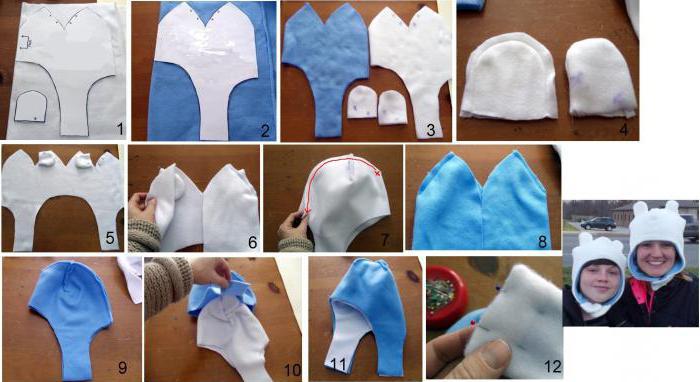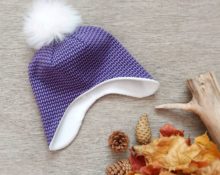 The cold season does not prevent children from running and playing outside, but voluminous hats and wrapped scarves tend to slide off or bunch up. An excellent solution would be a hat or helmet. Your child will be cozy and warm in it, and you don’t have to worry about the cold wind getting to your neck or ears. Be sure to try sewing one yourself!
The cold season does not prevent children from running and playing outside, but voluminous hats and wrapped scarves tend to slide off or bunch up. An excellent solution would be a hat or helmet. Your child will be cozy and warm in it, and you don’t have to worry about the cold wind getting to your neck or ears. Be sure to try sewing one yourself!
Hat-helmet: pattern according to measurements
To create a pattern you will need to take three measurements:
- Head circumference (measured across the brow ridges).
- Depth to the elastic band (from the eyebrows, through the crown, to the edge hairline).
- “Window” for the face (from eyebrows to chin).
- Forehead height.
- a (from eyebrows to hairline).
Advice! All measurements are taken with a tightly stretched tape to avoid distortion of the product in the future.
The pattern is built from the semicircle of the semicircle of the cutout for the face. If the fabric stretches a lot, subtract 2 cm.
- Width W is head circumference/2-radius+0.5cm.
- Forehead height B – finished measurement.
- Wedge width L= head circumference/4.The wedges are drawn by hand, the distance between them is darts. Angle a in wedges should be within 80–90O.
- Distance H – head circumference/4+2cm
Next, the pattern is transferred to the part folded in half.
What parts does the helmet consist of?
 If you are planning to sew a product for the off-season, then it is enough to choose thick and stretchy fleece fabric for the front and inside, and if the baby will wear a hat in winter, then you will need a padding polyester piece for the lining. All 3 parts are identical.
If you are planning to sew a product for the off-season, then it is enough to choose thick and stretchy fleece fabric for the front and inside, and if the baby will wear a hat in winter, then you will need a padding polyester piece for the lining. All 3 parts are identical.
Advice! The front fabric part is sewn 1.5-2 cm larger than the back part and insulation.
 And one more additional part is a ribbed or cash-corse binding, approximately 4–5 cm wide. Its length is calculated using the following formula: semicircle length for face *2*coefficient. stretchability of the binding
And one more additional part is a ribbed or cash-corse binding, approximately 4–5 cm wide. Its length is calculated using the following formula: semicircle length for face *2*coefficient. stretchability of the binding
Important! To determine the stretch coefficient of the binding, you need to measure a piece of binding without tension, for example, 10 cm, and then stretch it as much as possible, it will be 13.5. Divide 10/13.5=0.74
How to take measurements for a helmet
 To avoid errors in measurements, listen to the following tips.
To avoid errors in measurements, listen to the following tips.
- When measuring the circumference of the head, pass the tape over the child’s ears, because all people’s ears fit to the head to varying degrees, and this structural feature must be taken into account.
- Helmet depth to elastic band. It is more convenient to take this measurement in two stages from the forehead to the highest point of the head (crown), and from there to the neck.
Additional measurements are the width of the forehead and from temple to temple through the chin. Adding these values, we get a cutout for the face in a helmet.
Making a hat-helmet pattern for a boy
When all the necessary measurements have been taken, you don’t have to build a pattern from scratch yourself, but use one ready from the Internet, but taking into account the measurements obtained.

Advice! Even if you decide to trust the finished pattern with the indicated dimensions, try it on so that the finished product does not have to be altered!
When creating a pattern, the main thing is to take into account the fabric from which you are sewing, or rather, its stretch coefficient. The same model, sewn from different types of fabric, may vary by size or more!
How to sew a hat-helmet with your own hands
 Of course, the market for children's goods is crowded, but it often happens that you don't like anything on offer. Then, having spent a minimum of finances and a little free time, you can get an exclusive item, sewn with maternal love and care.
Of course, the market for children's goods is crowded, but it often happens that you don't like anything on offer. Then, having spent a minimum of finances and a little free time, you can get an exclusive item, sewn with maternal love and care.
What fabric is suitable for such a hat?
 It all depends on the time of year when the child will wear a hat. A helmet hat can serve not as a main hat, but as a scarf, so that the wind certainly does not blow and the baby does not catch a cold. After all, it fits tightly to the head, retaining heat. It is better to sew such a model from cotton, with the addition of elastic threads, this fabric has excellent stretch and you can sew the model without a fastener, it will be easy to put on and take off.
It all depends on the time of year when the child will wear a hat. A helmet hat can serve not as a main hat, but as a scarf, so that the wind certainly does not blow and the baby does not catch a cold. After all, it fits tightly to the head, retaining heat. It is better to sew such a model from cotton, with the addition of elastic threads, this fabric has excellent stretch and you can sew the model without a fastener, it will be easy to put on and take off.
For warmer models that act as the main hat, fleece of varying degrees of density is used. And the rich palette of shades will satisfy any fashionista!
Woolen fabric with elastane is wear-resistant and pleasant to the body, and cotton jersey is used for lining.
The insulation is traditionally synthetic winterizer or isosoft.
Advice! A practical solution is membrane inserts on the ears. They provide maximum protection from the wind and prevent the child from sweating.
We sew a hat-helmet for a boy with our own hands

When the pattern is ready and the fabric has been chosen, the most difficult, and at the same time interesting thing remains - sewing!
- We transfer the resulting pattern to the fabric and baste along the contour of the part.Using a pencil or tailor's felt-tip pen, draw lines along the basting.
Advice! If the fabric is colorful or printed, you can transfer it to the front side.
- Sew together the three central wedges of the hat. Darts can be “recessed” by 1.5 cm.
- Sew the back seam.
- We combine the side darts and make a seam, deepening it by 1.5-2 cm.
- We repeat all the points for the back part. You will get 2 hats.
- We close the pre-prepared binding into a circle, fold it in half and baste it.
- We fasten the parts of the hat, insert the binding inside, pin it together and grind it on a machine.
- In the central part of the wedge connection, the fastening is done manually with several stitches.
- The edges of the hat are processed using an overlocker or stitched with a fine zigzag.
All! Warm and comfortable hat - the helmet is ready! A nice bonus - it is double-sided!
Tips for sewing a hat
If you do not have much experience in sewing, then try sewing a hat - a helmet made of fleece. It is very easy to work with and does not require additional processing. And the finished product will be warm and beautiful.
Also, in order not to complicate the sewing process, you can use a pattern like a woman’s bonnet. In it, the back and side parts are slightly longer and will require a fastener. But overall the difficulty level is lower.
To make the entire sewing process as clear and simple as possible, watch this video:


 0
0





